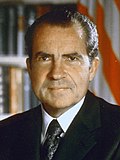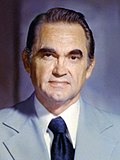| |||||||||||||||||||||||||||||||||
All 21 Michigan votes to the Electoral College | |||||||||||||||||||||||||||||||||
|---|---|---|---|---|---|---|---|---|---|---|---|---|---|---|---|---|---|---|---|---|---|---|---|---|---|---|---|---|---|---|---|---|---|
| Turnout | 66.8% | ||||||||||||||||||||||||||||||||
| |||||||||||||||||||||||||||||||||
 County results
| |||||||||||||||||||||||||||||||||
| |||||||||||||||||||||||||||||||||
| Elections in Michigan |
|---|
 |
The 1968 United States presidential election in Michigan was held on November 5, 1968. All 50 states and the District of Columbia participated in the 1968 United States presidential election. Voters chose 21 electors to represent them in the Electoral College, who voted for president and vice president.
Michigan was won by the Democratic Party candidate, Vice President Hubert Humphrey, defeating the Republican Party candidate, former vice president Richard Nixon, by a margin of 6.72%, making the state 6.79% more Democratic than the national average.[2] American Independent Party candidate George Wallace, former and future governor of Alabama, received 10% of the vote.
Humphrey's margin of victory was significantly narrower than President Lyndon B. Johnson's landslide 33.60-point triumph in 1964. American involvement in the Vietnam War and rioting throughout the country (including in Detroit) brought about unpopularity for the incumbent president and disenchantment towards his political agenda. Vice President Humphrey vowed to continue the policies of Johnson's Great Society and support civil rights for African Americans, while former vice president Nixon ran on a law and order platform focused on fighting crime and opposing the Johnson administration's handling of the war in Vietnam. Governor Wallace ran a right-wing populist campaign railing against rioting, desegregation, and the counterculture.
Although Wallace did not poll as well in the Midwest as he did in the South, he was able to appeal to blue-collar working-class voters who traditionally voted Democratic but had become disillusioned with crime and the civil-rights movement. As a result, he siphoned off enough votes to allow Nixon to win every state in the region except for Humphrey's home state of Minnesota and Michigan. Even with Michigan being Wallace's second-best Midwestern state behind Ohio, Humphrey was able to hold on to the Wolverine State's electoral votes for the Democrats once more, mainly by running up margins in heavily populated Wayne County (Detroit), neighboring Macomb and Monroe Counties, Genesee County (Flint), and the Upper Peninsula. Nixon would become the first Republican to win the White House without Michigan, a feat that only George W. Bush has repeated. Humphrey was the first losing Democrat to carry Michigan since Lewis Cass in 1848. Michigan would not vote Democratic again until 1992.
As of the 2020 presidential election[update], this is the last time that Wayne County cast more than a million votes.
- ^ "SOS - General Election Voter Registration/Turnout Statistics".
- ^ Leip, David. "Dave Leip's Atlas of U.S. Presidential Elections". uselectionatlas.org. Retrieved April 22, 2017.
Cite error: There are <ref group=lower-alpha> tags or {{efn}} templates on this page, but the references will not show without a {{reflist|group=lower-alpha}} template or {{notelist}} template (see the help page).



